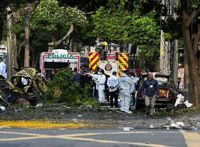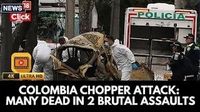Colombia is once again facing a surge of violence that has left its citizens on edge and its leaders scrambling for answers. In a span of just one day—August 21, 2025—the country was rocked by two devastating attacks: a car bombing in the bustling city of Cali and the downing of a police helicopter in the rural reaches of Antioquia. These incidents, which together claimed at least 19 lives and wounded more than 70, have thrown a harsh spotlight on the country’s deteriorating security landscape and the challenges facing President Gustavo Petro’s much-touted “total peace” initiative.
The attacks were not isolated events. According to the Associated Press, authorities quickly attributed both to renegade factions of the now-defunct Revolutionary Armed Forces of Colombia (FARC), a group that once terrorized the nation but had, at least officially, laid down arms following a 2016 peace accord. Yet, as so often in Colombia’s history, peace on paper has not translated into peace on the ground. Dissident FARC groups, splintered and emboldened, have continued their campaign of violence—this time, with new tactics and technology at their disposal.
In Antioquia, a police helicopter was shot down while transporting personnel to help eradicate coca leaf crops—the raw material for cocaine. The crash killed 13 police officers, a staggering loss for the country’s security forces. As reported by El País, the attack involved a drone that struck the helicopter’s tail rotor, sending it plummeting to the ground. This marks a significant shift in the way insurgent groups are waging war. “The use of drones is a worrying and important change in the way insurgent groups are attacking the state,” Cynthia Arnson, an adjunct professor at Johns Hopkins University, told the Associated Press. “They don’t need shoulder-fired anti-aircraft missiles anymore.”
The same day, violence erupted in Cali, Colombia’s third-largest city. A vehicle packed with explosives detonated near a military aviation school, killing six civilians and injuring more than 70 others. The blast was a chilling reminder of the urban terrorism that plagued Colombia in the 1990s, when drug lord Pablo Escobar waged open war against the state. President Petro was quick to respond, describing the Cali attack as a “terrorist reaction” by dissident FARC factions led by Iván Mordisco—a direct reprisal, he claimed, for a recent military offensive known as Operation Perseus.
Acting Defense Minister Ana Catalina Cano reinforced the administration’s hard line, declaring that the dissident groups, along with the Gulf Clan and Second Marquetalia, would now be considered terrorist organizations. “We are following the president’s instruction that the dissidents of alias Iván Mordisco, the Gulf Clan, and the Second Marquetalia will be considered terrorist organizations, prosecutable anywhere in the world for crimes against humanity,” she said in a video statement, as cited by El País.
The escalation of violence is not confined to the countryside. Traditionally, Colombia’s urban centers had been spared the worst of the conflict, with most violence contained to remote regions like Catatumbo, Cauca, and Putumayo. But as El País reports, the attack in Cali signals a dangerous new phase: insurgent groups are now willing and able to strike at the heart of major cities, far from their traditional strongholds. The Micay River canyon, just 93 miles from Cali, has become a vital corridor for drug trafficking and illicit crops—a power base for the Carlos Patiño front and its allies, all under the umbrella of Mordisco’s Central General Staff.
Petro’s response to this growing threat has been a blend of negotiation and force. Since taking office in 2022, he has launched talks with nine different insurgent groups and drug trafficking gangs, hoping to bring them to the negotiating table under his “total peace” strategy. Yet, as the Associated Press notes, only one small group has agreed to begin a transition toward civilian life. Critics argue that the policy has backfired, giving armed groups the breathing room they need to regroup and expand their influence. “Petro’s policy then allowed the armed groups to take advantage of ceasefires to strengthen themselves and their control over specific areas,” Arnson explained.
Meanwhile, the state’s ability to respond has been hamstrung by logistical woes. Colombia’s once-mighty aerial fleet, a symbol of state power during the administrations of Andrés Pastrana and Álvaro Uribe Vélez, is now a shadow of its former self. By the second half of 2024, nearly 60% of the fleet was grounded due to maintenance issues, obsolescence, and fuel shortages, according to security expert Jorge Mantilla. As he told El País, “They cannot fly either because they require maintenance, are obsolete, or there is no fuel.” Only a quarter of the helicopters were operational—a vulnerability that insurgent groups have been quick to exploit with drone attacks.
The numbers paint a grim picture. The area under coca leaf cultivation reached a record 253,000 hectares (about 625,000 acres) in 2023, according to the U.N. Office on Drugs and Crime. Drone attacks are on the rise, with 108 reported in 2024 and 118 already in 2025. These drones are not just dropping explosives; they’re also being used to monitor army movements and drug shipments, further tipping the balance of power away from the state.
As Colombia heads toward its presidential election in May 2026, the stakes could not be higher. The death of senator and presidential hopeful Miguel Uribe Turbay in June—a brazen assassination during a public rally in Bogotá—has only deepened the sense of crisis. Will Freeman, a fellow for Latin American Studies at the Council on Foreign Relations, warns that more “tactical displays of violence” are likely as the election nears. “Demonstrating their power through these kind of spectacular public attacks is a way to improve their negotiating position or send a strong message,” Freeman told the Associated Press.
The conflict has also evolved in other ways. Illegal groups are no longer just fighting for territory—they’re expanding into drug trafficking, illegal mining, extortion, and human trafficking. The International Committee of the Red Cross now recognizes eight distinct armed conflicts within Colombia, a far cry from the “post-conflict” optimism that followed the 2016 peace accord. While the country is not reliving the darkest days of the late 20th century—when massacres and bombings were a daily reality—the trend is unmistakably negative. Last year saw 22 massacres, a far cry from the 232 recorded in 2000, but Colombians’ concern for security is at its highest since before the peace agreement.
As the violence intensifies and the government struggles to regain control, many Colombians are left wondering whether peace is truly within reach—or whether the cycle of conflict will continue to repeat itself, with ever more sophisticated weapons and ever higher stakes.

